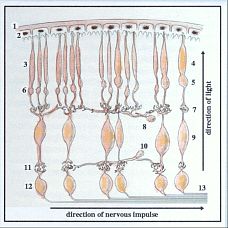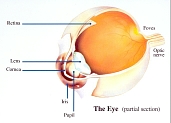| 
Diagram
of the structure of the retina
(1)
choroid; (2) pigmented epithelium; (3) and (4) sensitive
epithelium (layer of rods and cones) ; (5) necleus
of cones; (6) necleus of rods; (7) synaptic layer;
(8) horizontal cells; (9) layer of bipolar cells;
(10) inner associative cells; (11) synapses; (12)
layer of ganglion cells; (13) fibers of optic nerve
that carry the impulses to the brain. |
|

The
Eye ( partial section )
The
physiological study of the eye is fascinating for
a number of reasons. Firstly, the retina of the
eye appears to be an extension
of the brain. The retina can be described as a
net of a complex organisation of rods and cones,
which are identified by the shapes of the light-receptive
terminal members, sensitive to specific frequencies
of light. The rods are generally sensitive to
lightness and darkness, and are capable of intensifying
their response in very poor lighting conditions.
The eye and brain, automatically adjusts, and the
rods become an extremely sensitive detector in conditions
of low illumination. The cones operate however,
at relatively high light intensities and are particularly
sensitive to colour. |